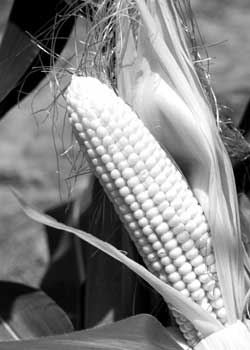|
Corn Growers Feel The Bite From A Bear Market
MISSISSIPPI STATE, MISS.
Who knew Mississippi corn growers should worry about bears? The bears are not in the fields eating the crop; they are in the market, eating the profits. When economists refer to a bear market, they are talking about declining stock prices over a prolonged period, usually a 20 percent or larger decline.
Brian Williams, agricultural economist with the Mississippi State University Extension Service, said several factors have pushed corn prices down in recent weeks.
“The U.S. Department of Agriculture’s planted acreage report, which was released June 30, did not help the corn market,” he said. “Then, the quarterly grain stocks report came out the same day indicating more corn in storage than anticipated. A week later, the world agricultural supply and demand estimates report suggested a drop in feed use and higher ending stocks. Those two reports really made prices tumble.”
Williams said December corn futures went from $4.47 per bushel on June 29 to $3.88 per bushel in just over two weeks. A year ago, national (futures) were trading around $5.27 per bushel.
“Another driver is the crop condition, released by USDA every Monday. Both Mississippi and the national crops are in very good condition. Currently, they are projecting the second largest crop nationally, just behind last year’s record,” he said.
The prospect of a second consecutive year of record or near record production could hurt growers who did not sell a portion of their crops early in the growing season.
Williams said there are 3.7 million fewer corn acres nationally. Soybeans are up 8.3 million acres, but soybean prices also are tumbling in anticipation of record crop this year.
“Corn and soybean prices tend to mirror each other,” he said.
Erick Larson, state Extension corn specialist, said the crop is looking generally good across most of Mississippi despite excessive rains during parts of the season.
“Rains during planting season delayed or restricted acreage in some areas with extremely cool or wet conditions in March and April,” Larson said. “Fields got a little dry in May to help overall crop prospects by allowing growers to get timely nitrogen and herbicide applications. Then conditions turned extremely wet in June in many areas causing some negative impacts, such as stunted growth, from soil saturation.”

Larson said he does not anticipate problems from cooler temperatures.
“Cooler temperatures should be very beneficial, especially if they persist for some time. Moderate nighttime temperatures are good for most of the crops we grow,” he said. “Below 72 in July is great news.”
Larson said southern rust has been detected in southeast Mississippi fields and has traveled in the wind up the eastern side of the state.
“Rust is a bit of an issue, but we hope the corn will outrun the extent of that injury,” he said. “As plants approach physiological maturity, we might see rust increase in later planted fields in the northeast part of the state.”
Dennis Reginelli, an Extension area agronomic crop agent, said growers have been watching isolated hot spots in Noxubee County since just after the Fourth of July.
“Growers are judging the maturity of the corn and the amount of rust to determine if treatments are necessary,” Reginelli said. “They are making field-to-field evaluations to determine if spray is needed based on maturity. Some fields can outrun the disease.”
Reginelli said growers are treating fields for rust if rain or irrigation is likely to spread the spores.
Tom Allen, Extension plant pathologist, said Diplodia ear rot and, to a lesser extent, some other ear rots also have been observed in scattered fields.
“Ear rots are normal when we have extended periods of rainfall during pollination since the fungi that cause those can easily enter the ear during rain or periods of extended dew,” Allen said. “Fungicides are not beneficial since application practices that rely on aerial applications would not be able to provide a fungicide at the point of infection.”
Allen said once the fungus has started to rot the ear, a fungicide would likely not arrest fungal development.
“Farmers should scout fields and focus on ear leaves that appear prematurely dried down or dead and observe corn ears for the presence of a white fungus growing on the ear itself,” he said. ∆
|
|